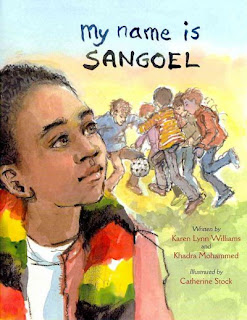Illustrator: Catherine Stock
Copyright: 2009
Publisher: Eerdmans Books for Young Readers
Williams,
K. L., Mohammed, K., & Stock, C. (2009). My name is Sangoel. Grand
Rapids, Mich.: Eerdmans Books for Young Readers.
Reading
Level: 3-4
Genre:
Historical fiction
Description:
Diversity, new environment, problem solving, change, hardship, loss.
Delivery
Suggestion: Individual.
Summary:
Sangoel is an eight-year-old boy who is forced to leave his homeland with his
mother and sister after his father is killed in the war in Sudan. Sangoel and
is family are a part of the Dinka tribe in southern Sudan, which is the largest
country in Africa. Their home life was very dangerous, as a war was taking
place. Sangoel was a refugee and him, his mother, and sister finally were given
the opportunity to flee from danger, and escape to America. However, Sangoel
was leaving behind his friends and other special family members, including the
Wise One, and his true identity. Settlement and adaption would not be easy for
Sangoel, as he is very different than all his classmates and peers in America.
Electronic
Resources:
Sudan Facts This resource provides viewers
with many important facts about Sudan, Africa. Students can use this resource
to become familiar with what Sangoel’s life was like back at home. Students
will then be able to have a clear understanding of why it is so difficult for
Sangoel to adapt in this new country. Students can compare the lifestyle and
environment of Sudan, Africa and the United States of America.
Refugees
This resource provides students with information about refugees through
informative text and also through poem. Students can get a better understanding
of what it is like to be a refugee and how it may feel for a young boy or girl
who was leave behind everything they know and come to a new country. This can
help students connect with Sangoel and see his perspective on the situation.
Vocabulary:
Refugee, Sudan, shivered, Dinka, barbed, translated, scrunched.
Teaching
Suggestions:
-Use
this book to discuss traditions and culture. Have students identify the
differences and similarities between each other’s backgrounds. Emphasize the
importance of all students’ cultures and backgrounds.
-Use
this book to discuss problem solving. Sangoel encounters an issue that is
impacting his identity and pride. However, rather than letting it continue and
spread, he comes up with a plan to solve it. Discuss the steps and sequence of
events that occurred in the story, which led to Sangoel solving his problem.
-Use
this book as a supplement to a social studies lesson regarding refugees, war,
persecution, and resettlement.
Comprehension
Strategies:
Before
Reading: Instruct students to first read the Authors’ Note on the last page of
the book. This will provide students with background knowledge about what is
taking place in the story. While students are reading the note, have them
identify any word or term that they may not know the meaning of. Such words or
terms may be, persecution, political ideas, ancestors, Americanized, heritage.
Then, have students locate the definitions of these words using a dictionary
source. Familiarity with these words and terms will provide students with a
better opportunity to comprehend the material in the story.
During
Reading: Have students stop after the scene where Sangoel, his mother, and
sister are at the dinner table and Sangoel is noticeably upset because he feels
that in America, he has lost his name. Instruct students to make predictions of
what Sangoel may do next. This is the turning part of the story where Sangoel
creates a plan to solve his problem. By predicting, students can become more
engaged as they anticipate what may come next, they can develop their thinking
skills while interacting with the text, and they can develop problem solving
skills by viewing the story through the characters perspective.
After
Reading: Have students make a replica of Sangoel’s creation by using their own
names. These works can be created on construction paper and displayed
throughout the classroom. This reflects on the importance of each individual’s
identity and their individuality.
Writing
Activity:
In
small groups, have student generate alternative ideas to potentially solve
Sangoels problem. Then, instruct students to write an alternative ending to the
story by formulating a different solution to Sangoels problem. Have students
meet back in their small groups and share their composed endings.

No comments:
Post a Comment